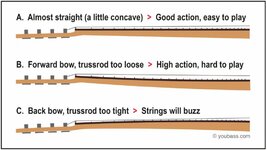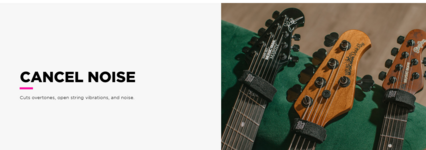MarkF786
Active member
- Joined
- Jan 6, 2011
- Messages
- 37
I've noticed EBMM's recommended method for measuring neck relief is very different than other guitar manufacturers (or experts like Dan Erlewine) - and if you follow EBMM's directions, it results in MUCH more relief then when following the more typical method.
To summarize the difference, EBMM recommends to fret the sixth string between the 2nd & 12th frets and measuring the relief at the 6th fret, while the more common method is to fret the string between first and last fret, and measuring at the 8th fret - and there's a HUGE difference between the results.
Is there a difference in EBMM's necks that leads to the different recommendations? What method do you use?
I just measured the relief using both methods, though using a 12" and 18" straightedge for even more precise results, and if I follow EMBB's method, I have .011" relief, but then following the Fender / Erlewine method, it's .024"!!! I've never seed recommended relief above .014".
P.S. For further details if interested:
EBMM's directions:
"First, check relief in the neck by holding the lowest (bass) string down on the second fret with your fretting hand, then hold it down on the 12th fret with your right thumb and tap on the string in the middle to show how straight the neck is. It should be no more than the thickness of a thick business card." Note, a business card is about 0.014" thick.
Fender's directions (which match Dan Erlewine's, though he recommends using a straightedge from the first to last fret, which is more accurate than using the string):
"Affix a capo at the first fret and depress the sixth string at the last fret. With a feeler gauge, check the gap between the bottom of the string and the top of the 8th fret". They recommend 0.10" relief.
To summarize the difference, EBMM recommends to fret the sixth string between the 2nd & 12th frets and measuring the relief at the 6th fret, while the more common method is to fret the string between first and last fret, and measuring at the 8th fret - and there's a HUGE difference between the results.
Is there a difference in EBMM's necks that leads to the different recommendations? What method do you use?
I just measured the relief using both methods, though using a 12" and 18" straightedge for even more precise results, and if I follow EMBB's method, I have .011" relief, but then following the Fender / Erlewine method, it's .024"!!! I've never seed recommended relief above .014".
P.S. For further details if interested:
EBMM's directions:
"First, check relief in the neck by holding the lowest (bass) string down on the second fret with your fretting hand, then hold it down on the 12th fret with your right thumb and tap on the string in the middle to show how straight the neck is. It should be no more than the thickness of a thick business card." Note, a business card is about 0.014" thick.
Fender's directions (which match Dan Erlewine's, though he recommends using a straightedge from the first to last fret, which is more accurate than using the string):
"Affix a capo at the first fret and depress the sixth string at the last fret. With a feeler gauge, check the gap between the bottom of the string and the top of the 8th fret". They recommend 0.10" relief.
Last edited:






